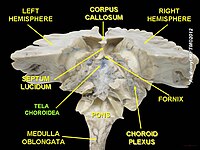
Photo from wikipedia
Organized human choroid-plexus organoids that secrete cerebral spinal fluid (CSF) can be generated from human pluripotent stem cells and mimic the CNS barrier so that molecules that permeate it (including… Click to show full abstract
Organized human choroid-plexus organoids that secrete cerebral spinal fluid (CSF) can be generated from human pluripotent stem cells and mimic the CNS barrier so that molecules that permeate it (including therapies) can be identified. The choroid plexus is an epithelial layer that forms the blood–CSF barrier. The CSF is secreted by the choroid plexus and contains hormones, other signaling molecules and nutrients, although the functions of the molecules within it are far from understood. Among other question about this barrier are those about the functional heterogeneity and permeability of the choroid plexus. To study the choroid plexus and CSF further, Pellegrini et al. modify the protocol for deriving cerebral organoids. Their choroid-plexus organoids are molecularly similar to the choroid plexus in vivo and, notably, organize into distinct compartments and secrete CSF, which will allow further study of the important blood–CSF barrier.
Journal Title: Nature Medicine
Year Published: 2020
Link to full text (if available)
Share on Social Media: Sign Up to like & get
recommendations!